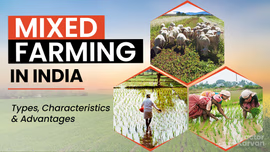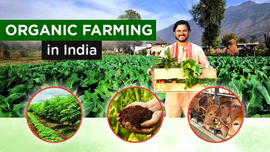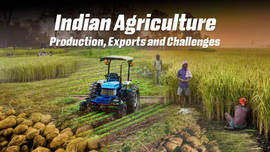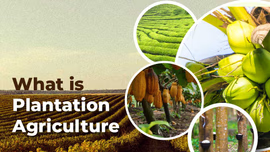Soil Erosion in India: Causes, Effects and Prevention

Soil is the uppermost layer of Earth's crust. It is formed mainly due to the breakdown of rocks with respect to the climate, topography and vegetation of the region over a long period of time. Soil erosion is one of the natural calamities that cause soil degradation, which in turn affects the surrounding biodiversity and ecosystem. It is a severe problem in India that needs to be addressed quickly. Hence, healthy soil is essential in agriculture. Read on to learn the concept of soil erosion, its causes, effects, and prevention.
Table of Contents
- What is Soil Erosion?
- What are the Main Causes of Soil Erosion?
- What are the Effects of Soil Erosion in Agriculture?
- What are the Environmental Impacts of Soil Erosion in India?
- What are the Remedial Strategies for Prevention of Soil Erosion?
- What are the Government Initiatives to Reduce Soil Erosion?
What is Soil Erosion?
Soil erosion is the detachment of soil particles from one place to another due to natural and human causes. In soil erosion, the topmost layer washes away to faraway lands, rivers and valleys. The degraded soil loses its quality and structure, making it more susceptible to erosion. Soil erosion occurs mainly on steep slopes with heavy rainfall in states such as Assam, Manipur, and the Western Ghats. It also occurs in Maharashtra, Andhra Pradesh and Tamil Nadu. Soil compaction, loss of soil structure, low organic matter, poor internal drainage, and soil acidity are other problems that contribute to soil erosion.
What are the Main Causes of Soil Erosion?
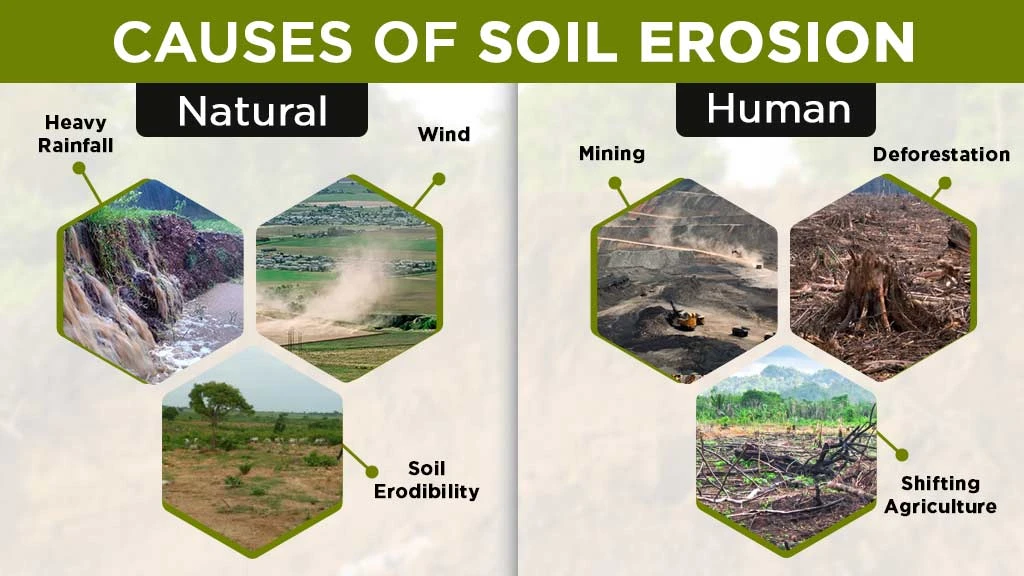
Soil erosion can occur naturally or as a result of human activities. Let's discuss each of them separately.
Natural Causes
Heavy Rainfall: India experiences diverse climatic conditions throughout the year. In some areas where heavy rainfall occurs, it can carry away soil nutrients and quality, leading to soil erosion, particularly in hilly or sloping terrains.
Wind: Soil erosion occurs mainly in less vegetative places, particularly in desert and semi-desert regions where strong breezes are very common. The small, dry particles of soil are carried away by the wind and deposited elsewhere. This wind washing of the topsoil is known as wind erosion, a natural cause of soil erosion.
Soil Erodibility: Some soils are more prone to erosion than others, and factors like organic matter content, structure, texture and permeability affect soil erodibility more.
Local Climate and Vegetation Loss: Local climate is one of the reasons for soil erosion. It typically occurs due to sudden changes in weather. Additionally, a well-vegetated area acts as a shield between the soil and raindrops, breaking down the wind before it can reach the soil. Thus, vegetation loss is also a contributing factor to soil erosion.
Human Causes
Mining: Mining is one of the major human causes of soil erosion. It removes the top layer of soil, which can cause loss of soil structure, and the compacted soil is more prone to erosion. It also leaves heavy metals and sediments near water bodies, reducing the water quality.
Deforestation: Deforestation is the leading cause of soil erosion as the cutting of trees leads to the detachment of the roots, which causes the loss of soil structure. Trees shield the soil from heavy rainfall and maintain soil temperature, which reduces evaporation. Deforestation leads to excessive soil erosion, which increases runoff.
Shifting Agriculture: Another significant human cause of soil erosion is shifting agriculture. This practice involves the temporary cultivation of land, followed by abandonment to allow it to revert to its natural state. However, this process leads to the loss of soil structure and nutrients, ultimately degrading the soil quality.
What are the Effects of Soil Erosion in Agriculture?
Soil erosion has a significant impact on agriculture, as the most fertile soil loses its richness, thereby decreasing soil productivity. Here are some significant impacts of soil erosion on agriculture:
Land Degradation
The two types of natural soil erosion, water and wind erosion, are the major causes of land degradation. Approximately 75 billion tons of soil are eroded annually, at a rate that is 13-40 times faster than the natural rate of erosion. Around 40% of the soil is degraded in the world.
Water Pollution
Water pollution is primary cause of soil erosion. The eroded soil consists of pesticides, heavy metals, and fertilizers, which mix with water and causes water pollution. It is harmful for aquatic life forms and destroys marine and freshwater habitats.
Dust Pollution
During wind erosion, dust particles mix with toxic chemicals such as pesticides or petroleum fuels, that result in breathing problems when inhaled.
Destruction of Infrastructure Soil erosion has a negative impact on dams and drainages. It limits their operational lifetime and efficiency.
Decreased Soil Fertility
Topsoil, which is the most fertile layer of soil, is important for farming. It is rich in nutrients, organic matter, and microorganisms that are essential for plant growth. However, soil erosion can wash away the topsoil, resulting in decreased soil fertility, difference in soil structure, and pH imbalance, all of which can impact the growth of crops.
Rise in Pest Problem
During soil erosion, the reduced nutrient content weakens the soil, making it more vulnerable to pest infestations.
What are the Environmental Impacts of Soil Erosion in India?
Soil erosion does not have a negative impact on agriculture alone. It causes decay in aquatic inhabitants and crops, sedimentation, biodiversity loss, and frequent flooding.
Regular Flooding Events: The risk of frequent flooding increases when forests are converted into pastures or fields, as the trees' roots help stabilize the soil. Such regions also lose their infiltration properties, which contributes to waterlogging and flooding.
Biodiversity Loss: The eroded fields have thin vegetation, which becomes increasingly barren over time. It means the decay of local flora and fauna because many organisms are deprived of their natural habitats. The biodiversity loss also causes an imbalance in the ecosystem.
Blocked Waterways and Polluted Aquatics: Waterway clogging and siltation are long-term effects of soil erosion. Additionally, eroded matters develop sedimentation in even regions and also clogs grassed waterways, water pumps, and dams. The water currents from the fields contain chemicals that are highly toxic to animals and humans, and they also contaminate the drinking water.
Reduced Greenhouse Gas Sequestration: Trees and vegetation are a significant source of carbon dioxide sequestration, but eroded lands can hardly support their growth. Sustainable management can enhance the condition and prevent the loss of carbon-sequestering vegetation, thereby minimizing the production of greenhouse gases associated with deforestation.
What are the Remedial Strategies for Prevention of Soil Erosion?
There are two types of preventive measures to control soil erosion. Let's discuss each in detail.
Biological Measures
Strip Cropping: Strip cropping involves planting erosion-permitting crops (jowar, bajra, maize) with erosion-checking close-growing crops (grasses, pulses). They conserve soil moisture and reduce soil erosion by protecting the natural structure and organic matter in the unploughed regions.
Crop Rotation: Crop rotation helps control soil erosion by allowing the soil to remain undisturbed through the alternating of crops. It plays a crucial role in improving soil structure and allowing organic matter to build up for the upcoming crops.
Organic Manures: Using organic manure like cow dung and green manure in agricultural fields improves the overall moisture of the soil. It also increases infiltration and permeability in the soil.
Stubble Mulching: Stubble mulching can help control wind erosion by keeping the stubble or mulch in place on the soil.
Mechanical Measures
Contour Tillage: Contour tillage is the tilling process in contour farming in which tillage should be done at the right angle to the slopes. Through this, each furrow cuts off the flowing water, allowing it to soak into the soil.
Terracing: Terracing is practised all over India to control soil erosion. Cultivating sloping lands into flat surfaces reduces the amount of water flowing across the soil surface, thus preventing soil erosion.
Rainwater Harvesting: Rainwater harvesting is another crucial measure for controlling soil erosion. You can collect and store rainwater through this process, which reduces the surface runoff.
What are the Government Initiatives to Reduce Soil Erosion?
National Mission for Sustainable Agriculture (NMSA): NMSA was launched by the Department of Agriculture and Farmer's Welfare in 2014-15. The scheme aims to enhance agricultural productivity, particularly in rainfed areas, by focusing on integrated farming, water use efficiency, soil health management, and synergizing resource conservation.
Soil Health Card Scheme: The Soil Health Card scheme was launched in 2015 with the aim of improving farmers' soil quality and profitability, as well as generating employment opportunities for rural youth. This card monitors the health of the soil, enabling farmers to determine which crops to cultivate in their agricultural fields. This scheme has been merged with the Rashtriya Krishi Vikas Yojana (RKVY) cafeteria scheme as one of its components under the name 'Soil Health & Fertility' from 2022-23.
Paramparagat Krishi Vikas Yojana (PKVY): As an extended component of Soil Health Management (SHM) under the National Mission on Sustainable Agriculture (NMSA), the PKVY plays a crucial role in promoting and supporting organic farming. Its primary objective is to enhance soil health through the adoption of organic farming practices.
Frequently Asked Questions On Soil Erosion in India: Causes, Effects and Prevention
1. What is soil erosion?
Soil erosion is the detachment of soil particles from one location to another due to natural and human causes.
2. What is the main cause of soil erosion in India?
Heavy rainfall, soil erodibility and deforestation are some causes of soil erosion in India.
3. How can we prevent soil erosion?
We can reduce soil erosion by adopting some remedial strategies such as strip cropping, crop rotation, terracing and stubble mulching.
4. What are the two major types of natural soil erosion in India?
Wind erosion and water erosion are the two major types of natural soil erosion in India.
5. What human activities are responsible for soil erosion?
Deforestation and mining are the major human activities that lead to soil erosion.


Related Blogs
